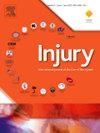老年人前十字韧带重建术:5 年随访研究。
IF 2.2
3区 医学
Q3 CRITICAL CARE MEDICINE
Injury-International Journal of the Care of the Injured
Pub Date : 2024-09-01
DOI:10.1016/j.injury.2024.111529
引用次数: 0
摘要
背景:老年人的活动时间更长,而且在晚年仍会继续进行需要单腿旋转的运动和活动。因此,40 岁以上人群的前交叉韧带(ACL)撕裂率在不断上升,手术重建(ACLR)的比例也随之增加,但有关其有效性的文献却很有限。我们的目的是比较接受前交叉韧带重建术的老年患者和年轻患者的疗效:研究纳入了2015年至2017年期间在一家一级创伤中心接受前交叉韧带置换术并进行骨-髌腱-骨移植(BPTB)的患者,随访5年。患者分为 4 组:40 岁以下、40-49 岁、50-59 岁和 60 岁以上。移植物功能通过国际膝关节文献委员会(IKDC)客观评分进行评估,前后(AP)位移通过关节测量仪(KT-1000;MEDMetric)进行测量,Lysholm量表用于主观评估:结果:195 名患者被纳入最终分析。IKDC评分显示,50-59岁和60岁以上组的评分明显低于年轻组,但分别有83%和66%的病例达到正常或接近正常等级。在膝关节AP位移(以毫米为单位)方面,40岁以下组与50-59岁组和60岁以上组之间存在明显差异;但在这些高龄组中,移植物失败(松弛>5毫米)和伸长(>3毫米)的数量并未增加。40-49岁组、50-59岁组和60岁组患者报告的Lysholm评分低于40岁以下组,但平均评分为 "良好":结论:老年运动员前交叉韧带重建术的长期效果与年轻患者相当,无论是膝关节功能还是患者满意度。此外,40 岁以上的老年患者与 50 岁甚至 60 岁的患者相比,疗效并无差异。本文章由计算机程序翻译,如有差异,请以英文原文为准。
Anterior cruciate ligament reconstruction in the elderly: 5-Year follow-up study
Background
Older adults remain active for longer and continue sports and activities that require rotation on one leg later in life. The rate of anterior cruciate ligament (ACL) tears is therefore increasing in those over 40 years old, with an associated increase in the rate of surgical reconstruction (ACLR), but there is limited literature on its effectiveness. Our aim was to compare the outcomes of elderly patients who have undergone ACLR with those of a younger group of patients.
Materials and Methods
Patients who underwent ACLR with bone-patella tendon-bone grafting (BPTB) at a level I trauma center between 2015 and 2017 were included in the study with a 5-year follow-up. Patients were divided into 4 groups: below 40 years, 40–49 years, 50–59 years and over 60 years. The graft function was evaluated by the International Knee Documentation Committee (IKDC) Objective Score, the anteroposterior (AP) displacement was measured by arthrometer (KT-1000; MEDMetric) and the Lysholm scale was used for subjective evaluation.
Results
195 patients were included in the final analysis. The IKDC score showed significantly poorer scores in the 50–59 years and over 60 years group than in the younger groups, however in 83 % and 66 % of cases reached normal or nearly normal grades, respectively. A significant difference was found in the knee AP displacement (measured in mm) between the below 40 years group and 50–59 years as well as over 60 years old groups; however, the number of graft failure (laxity >5 mm) and elongation (>3 mm) did not increased in these senior groups. The patient-reported Lysholm scores in the 40–49 years, 50–59 years and 60 years groups was lower than in the below 40 years group, but the average score was “good”.
Conclusions
The long-term results of ACL reconstruction in older athletes are comparable to those of younger patients, both in terms of knee function and patient satisfaction. Furthermore, there is no difference in outcomes for older patients over the age of 40 compared to those in their 50 s or even 60 s. There is still insufficient published evidence to define an upper age limit for ACL reconstruction in older athletes.
求助全文
通过发布文献求助,成功后即可免费获取论文全文。
去求助
来源期刊
CiteScore
4.00
自引率
8.00%
发文量
699
审稿时长
96 days
期刊介绍:
Injury was founded in 1969 and is an international journal dealing with all aspects of trauma care and accident surgery. Our primary aim is to facilitate the exchange of ideas, techniques and information among all members of the trauma team.

 求助内容:
求助内容: 应助结果提醒方式:
应助结果提醒方式:


